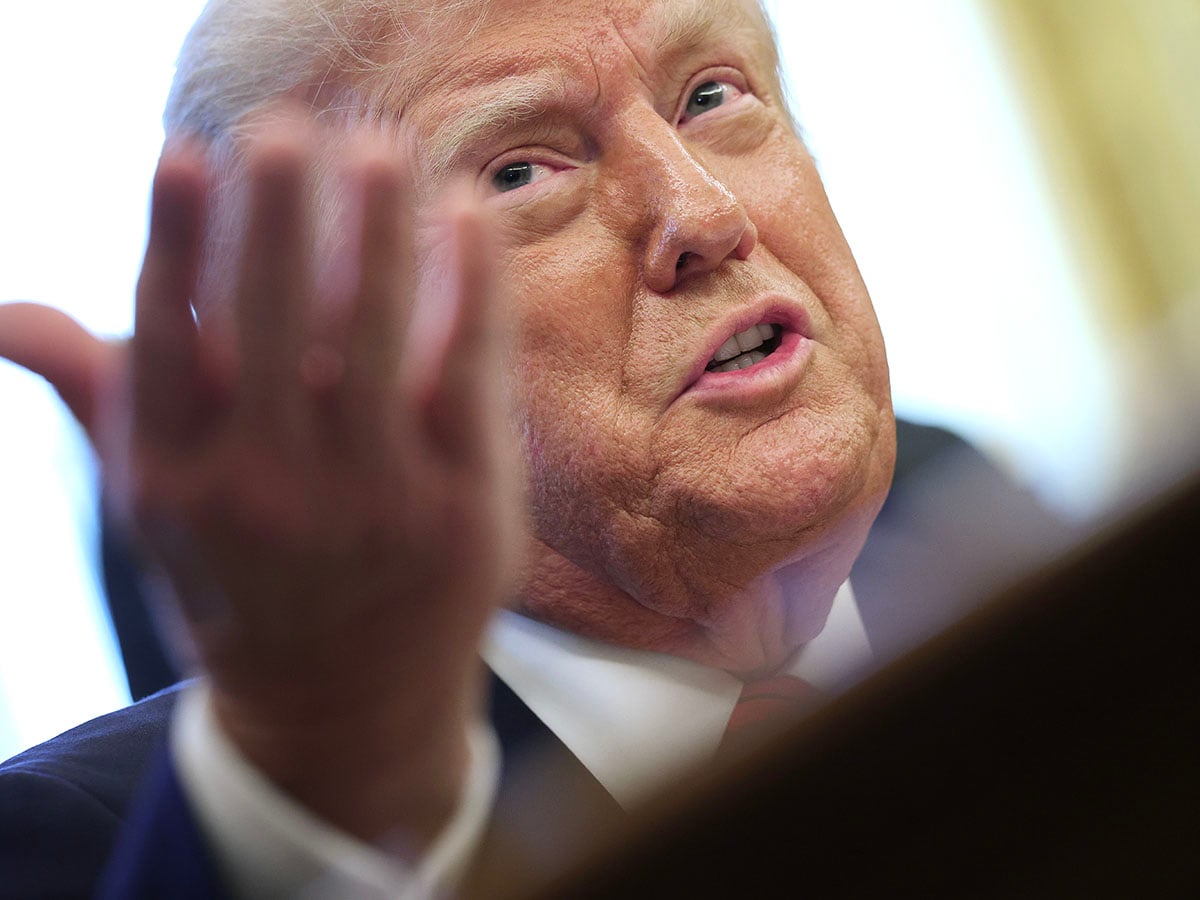 According to Morgan Stanley, benchmark index Sensex may reach 82,000 by the year-end, downgrading from its earlier target of 93,000.
According to Morgan Stanley, benchmark index Sensex may reach 82,000 by the year-end, downgrading from its earlier target of 93,000.
Image: Reuters/Francis Mascarenhas/File Photo
Even with battered sentiment and anxiety around uncertain rising tariffs, Indian stock markets have staged a comeback in just few weeks. However, the real concern is if such a recovery is resilient, or the rally is built on wafer-thin expectations of global economic environment getting back to its feet.
Analysts believe it is the latter. Factors such as significant disruption of global economies due to a potential trade war, slowdown in domestic capex, weak corporate earnings, valuation metrics of stocks, steep volatility in currencies and sluggish consumer demand may have a negative influence on stock markets recovery in India. Besides, foreign institutional investors have been wary of parking funds into domestic shores as they see Indian stocks as riskier asset as of now.
According to Morgan Stanley, benchmark index Sensex may reach 82,000 by the year-end, downgrading from its earlier target of 93,000.
“This level assumes continuation in India’s gains in macro stability via fiscal consolidation, increased private investment, and a positive gap between real growth and real rates. Robust domestic growth, slow growth in the US but no recession, and benign oil prices are also part of our assumptions. In our base case, we also assume that the bulk of the tariff news is out,” says Ridham Desai, MD and chief equity strategist India, Morgan Stanley.
Morgan Stanley has also slashed corporate earnings estimates about 13 percent by FY26 driven by the global situation.
In a worst case, scenario with a 20 percent probability, he sees Sensex tanking to 63,000-levels. This assumption is based on grim factors such as oil prices surging past $100 per barrel, the Reserve Bank of India tightening to protect macro stability, global growth slowdown meaningfully, and the US slipping into recession.
However, in a bull case scenario which has a 30 percent probability, Desai sees Sensex at 91,000 by December.
Terming it as stock pickers’ market, Desai says that markets are transitioning from one driven by macro conditions to one where stock-picking is likely to add alpha (create value).
India markets have significantly recovered from the jarring sell-off in first week of April due to higher tariffs imposed by US President Donald Trump effective April 2. On April 9, Trump announced a 90-day pause on his sweeping tariffs on all countries except China, something that seemed impossible just 24 hours ago. As a result, US markets were euphoric and bounced back, with the S&P rallying 9 percent, its largest daily gain since 2008.
Trump singled out China, the largest exporter to the US, and subsequently raised its tariffs to 125 percent, up from 104 percent earlier. The cumulative tariff rate on China is now 145 percent.
In addition, the White House stressed that the “baseline” 10 percent tariff on imports from most other nations would remain in effect during the 90-day pause. This follows an earlier executive order of tripling the tariff on smaller parcels from China valued at less than $800 from 30 percent to 90 percent effective May 2—a move that affects an estimated annual $40-45 billion of largely e-commerce imports.
Investors flocked to Indian stocks too. Both Sensex and Nifty galloped with around 10 percent gains from the lows it had hit on April 7. This follows a loss of 8 percent in the previous week. Since then, even BSE Mid and Smallcap have gained nearly 9-10 percent.
However, analysts at Nomura are not optimistic about a firm recovery of Indian markets. Saion Mukherjee, MD and head of India equity research, Nomura has reset Nifty target at 24,970 for March 2026. The projection is based on 19.5 times FY27 Nifty earnings per share (EPS) of Rs 1,280, after factoring in a 5 percent cut to current consensus estimates.
“We raise the target valuation multiple from 18.5 times earlier to factor in the drop in yields, assuming no material increase in risk premium. In case of a stable risk environment, we expect FII flows to be supportive after the intense sell-off in the past six months. Assuming a valuation range of 17-20 times, we expect market return of (-)9 percent to (+)7 percent over the next one year,” Mukherjee explains.
India is likely to be adversely impacted from ongoing trade as global growth slows down. India’s goods and services exports at $450 billion and $375 billion are 23 percent of GDP (2024). The impact on the economy is likely to be more from a slowdown in services and the impact from goods is likely to be rather limited as India runs a trade deficit with the US, says Mukherjee. The uncertainty of the trade war and tariff negotiations can lead a long period of indecisiveness.
“This shall adversely impact the business sentiment and will negatively impact investments by the businesses. Therefore, the private sector capex is likely to remain slow in the near term,” Mukherjee adds.
Also read: Trump’s tariff tantrums send markets on a topsy-turvy ride
Volatility: Ebb and flow
The total market capitalisation of all BSE-listed companies has now crossed the $5 trillion mark for the first time in three months, with the recent recovery in markets. India’s equity market had slipped to $4.5 trillion m-cap on April 7. It has recovered by over $500 billion in the period.
However, it has been challenging to keep up with the steep volatility in markets as investors are swinging to the flip-flop changes by Trump in the tariff policy. For instance, on April 7 India volatility index or India VIX jumped 66 percent in a single day. Immediately, next day India VIX cooled off 10 percent and subsequent increase of 5 percent on tariff pause.
The VIX index is the most closely watched by traders as a measure of the expected volatility of stock markets over an ensuing 30-day period and is traders’ main way of protecting against or betting on sharp moves in stocks. Investors, research analysts and portfolio managers look to VIX values as a way to measure market risk, fear and stress before they take investment decisions.
In the month of April so far, India VIX has heated up 22 percent.
Typically, the VIX and boarder indices have an inverse relation, especially in times of uncertainty-led panic sell-off in equities by investors. India VIX usually rises when there is panic or uncertainty in the market. However, in the last six months, despite the market falling significantly, VIX has remained low.
Historical performance of India VIX in past two specific occasions- the US sub-prime crisis and during Covid-led worldwide lockdowns India VIX spiked to record levels, crossing the 90 levels. Since then, it has cooled off as both global and Indian markets, have witnessed a spectacular bull market.
 On April 9, Trump announced a 90-day pause on his sweeping tariffs on all countries except China, something that seemed impossible just 24 hours ago.
On April 9, Trump announced a 90-day pause on his sweeping tariffs on all countries except China, something that seemed impossible just 24 hours ago.
Image: Win McNamee/Getty Images
Monsoon and impact on corporate earnings
Since September 2024, Bloomberg consensus estimates of India corporate earnings for stocks in BSE 200 have fallen by 6 percent for FY26/27. Given potentially slower economic growth, Mukherjee thinks there is downside risk to the current consensus earnings estimates.
He expects earnings growth, at best, to be in line with nominal GDP growth in the near term, as the earnings-to-GDP ratio is already at elevated levels. Slowdown in capex and exports and weak consumer sentiment are a drag, negated to an extent by lower raw material prices.
“We expect another 5 percent reduction in consensus earnings estimates for FY26/27,” Mukherjee says.
However, an above-normal monsoon this season may lift limping consumption demand in rural economy. The Indian Meteorological Department (IMD) forecast of an above-normal monsoon while Skymet’ also predicts a normal monsoon.
Fall in inflation, better monsoon and food production are positive for rural growth. Nomura’s analysis suggests that there is uneven recovery in rural India with positive momentum in the farming sector but weakness sustain in the non-farm segment. Urban consumption still remains weak.
Household financial savings are still close to multi-year lows with only a marginal recovery in FY24, from the bottom of FY23. Weak income growth, high inflation and higher borrowing had impacted the financial savings adversely. The households may focus on improving the financial savings which shall adversely impact consumption.
There is also scope to pass on the impact of lower oil prices to consumers in case the prices remain low. However, the government increased excise duty on petroleum products to gain additional revenues rather than passing on the benefit to consumers.
